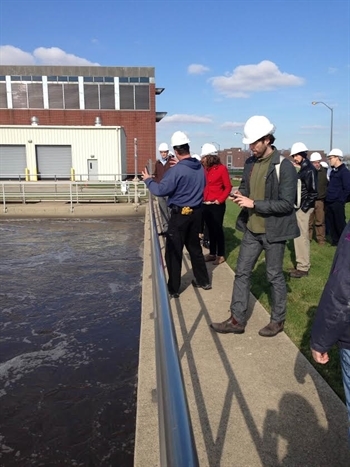
Kate Calabra
This settling tank is one of the final stages of water purification.
Fall is here and that means we get to enjoy the scents of warm apple cider, pumpkin spice everything, freshly baked pies, and for the Calumet Stormwater Collaborative, a stewing batch of wastewater.

Kate Calabra
The Calumet Stormwater Collaborative tours the Calumet Water Reclamation Plant.
The Calumet Stormwater Collaborative is pursuing solutions that address local flooding, declining infrastructure performance, and a lack of long-term capital improvement planning for green and grey stormwater systems. To optimize impact, the Collaborative emphasizes the importance of coordination between governments and stakeholders.
On Friday, Nov. 7, the Collaborative kicked off the season with a tour of the oldest and second-largest wastewater treatment plant in metropolitan Chicago. The Calumet Water Reclamation Plant is one of seven wastewater treatment plants run by the Metropolitan Water Reclamation District of Greater Chicago to clean and recycle used water. The plant is responsible for cleaning over 300 million gallons of the region’s wastewater on a daily basis. It neighbors the Tunnel and Reservoir Plan, a deep tunnel system that when complete will capture, store and treat combined sewer overflows, a not-so-tasty cocktail of sewage and rainwater. The Calumet Water Reclamation Plant works all day, every day to keep up with flows.
A 2x4 wooden board recently swam through the sewer system all the way to the screening stage.
The Collaborative was led through the plant and witnessed the two main stages of water treatment. Primary treatment first removes debris through the use of screens. These screens contribute to the cleaning process, but also protect the plant’s more sensitive equipment. Our tour guide shared a story of a courageous 2x4 wooden board that swam through the sewer system all the way to the screening stage, which is both impressive and concerning. Large items in the sewer system can severely damage the machinery used to clean our water, bringing the process to a halt. So, be mindful of what you put down your drains or in our waterways.

Kate Calabra
These arms skim fats, oils and grease off the top of the water.
After screening, water then travels through chambers that remove other contaminants, such as sand or grit. In the final phase of primary treatment, the water goes to a settling tank large enough for a SeaWorld show. In the settling tank, fats, oils and grease are skimmed from the top by revolving “arms.” At this point, the visible contamination has been extracted and it’s time to move on to secondary treatment.
During secondary treatment, the water is sent through aeration tanks, where micro-organisms, referred to as bugs, eat away at any remaining organic materials or nutrients. Once the bugs are done snacking, the water is put into another settling tank and separated from the bugs and their leftovers. The result is clean water that is sent back into our region’s waterways.
Currently, the plant is installing a tertiary treatment system, which will work to further disinfect the water through the use of chlorine and should come online in December 2015.
It is hard to leave the plant without a greater appreciation of the clean water that we in the Chicago region are privileged to have. Water is a finite resource that takes a lot of time, energy and money to treat for drinking, but then again to recycle and return to our waterways. While treatment plants such as the Calumet are very powerful facilities, they are challenged to keep pace with the rate at which residents use water and the increasing severity of rainfall events. With that in mind, it is important to differentiate between what is waste and what is wasteful. Forming simple habits and prioritizing water consumption at home is a way for everyone to contribute to water conservation and a way to acknowledge the hard work that goes into maintaining our region’s water supply.